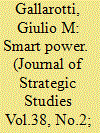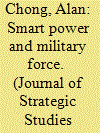| Srl | Item |
| 1 |
ID:
137255


|
|
|
|
|
| Summary/Abstract |
The analyses of smart and soft power have developed little beyond what their critics would refer to as ‘soft theory’, and in both cases the theoretical development is less than ‘smart’. This article attempts to address these deficiencies in the theoretical development of smart power by: (1) articulating a more rigorous and systematic understanding of the processes of smart power; (2) explaining how changes in world politics have raised the value of smart power relative to hard power; (3) analyzing smart power in the context of recent US foreign policy, and (4) proposing several prescriptions that will encourage decision-makers to value and effectively use smart power strategies in their foreign policies.
|
|
|
|
|
|
|
|
|
|
|
|
|
|
|
|
| 2 |
ID:
137256


|
|
|
|
|
| Summary/Abstract |
From Iraq to the Gulf of Aden and the South Pacific, this paper evaluates how far theoretical ideas about smart power manifest in operational missions of the Japan Self-Defense Forces (JSDF). To function within a ‘smart’ power context, this paper suggests that JSDF operates in ‘assisting’ mode, rather than the ‘threatening’ behavior of ‘hard’ power. JSDF also deployed alongside other Japanese ‘soft’ power tools – diplomatic, cultural, developmental, and NGOs, using tailored programs for different cultural and geographical contexts. Given constitutional constraints and public sensitivity towards coercive force, JSDF missions could be integrated more into a ‘whole-of-government’ approach advancing foreign policy goals through ‘smart power’.
|
|
|
|
|
|
|
|
|
|
|
|
|
|
|
|
| 3 |
ID:
137254


|
|
|
|
|
| Summary/Abstract |
Smart power is comprised of two elements: the quest for building society among states and between states and non-state actors; as well as the desire for cleaner forms of power projection. This special issue explores how states continue to fumble over achieving the optimum mix of hard and soft power across several country cases and themed articles. This set of contributions suggests that smart power is not unlike a ‘Swiss Army Knife’ analogy: multifunctional and challenging to choose the right combination of ideational and material tools.
|
|
|
|
|
|
|
|
|
|
|
|
|
|
|
|